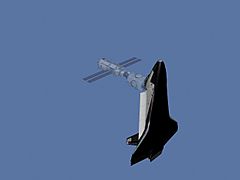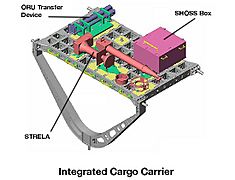STS-96 facts for kids
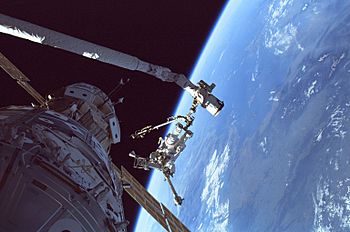
Jernigan outside Unity, during the mission's only EVA
|
|
| Mission type | ISS assembly ISS logistics |
|---|---|
| Operator | NASA |
| Mission duration | 9 days, 19 hours, 13 minutes, 57 seconds |
| Distance travelled | 6,000,000 kilometres (3,700,000 mi) |
| Spacecraft properties | |
| Spacecraft | Space Shuttle Discovery |
| Launch mass | 118,857 kilograms (262,035 lb) |
| Landing mass | 100,230 kilograms (220,980 lb) |
| Payload mass | 9,097 kilograms (20,056 lb) |
| Crew | |
| Crew size | 7 |
| Members |
|
| Start of mission | |
| Launch date | 27 May 1999, 10:49:42 UTC |
| Launch site | Kennedy LC-39B |
| End of mission | |
| Landing date | 6 June 1999, 06:02:43 UTC |
| Landing site | Kennedy SLF Runway 15 |
| Orbital parameters | |
| Reference system | Geocentric |
| Regime | Low Earth |
| Perigee | 326 kilometres (203 mi) |
| Apogee | 340 kilometres (210 mi) |
| Inclination | 51.6 degrees |
| Period | 91.2 min |
| Docking with ISS | |
| Docking port | PMA-2 (Unity forward) |
| Docking date | 29 May 1999, 04:23 UTC |
| Undocking date | 3 June 1999, 22:39 UTC |
| Time docked | 5 days, 18 hours, 15 minutes |
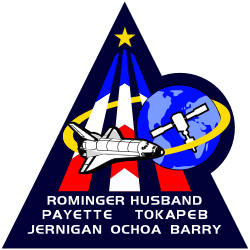  Left to right - Front row: Rominger, Ochoa, Husband; Back row: Barry, Payette, Tokarev, Jernigan |
|
STS-96 was a Space Shuttle mission to the International Space Station (ISS). It was the first time a Space Shuttle docked with the ISS. The mission used the Space Shuttle Discovery. It carried a special module called Spacehab, which was full of supplies for the space station.
The shuttle launched from Kennedy Space Center, Florida, on May 27, 1999. It returned to Kennedy on June 6, 1999.
Contents
Meet the Astronauts: The STS-96 Crew
| Position | Astronaut | |
|---|---|---|
| Commander | Fourth spaceflight |
|
| Pilot | First spaceflight |
|
| Mission Specialist 1 | Second spaceflight |
|
| Mission Specialist 2 | Third spaceflight |
|
| Mission Specialist 3 | Fifth and last spaceflight |
|
| Mission Specialist 4 | First spaceflight |
|
| Mission Specialist 5 | First spaceflight |
|
Space Walk: Working Outside the Station
During the mission, two astronauts, Tamara E. Jernigan and Daniel T. Barry, went on a spacewalk. This was a very important part of their work.
- Astronauts: Jernigan and Barry
- Start of Spacewalk: May 30, 1999 – 02:56 UTC
- End of Spacewalk: May 30, 1999 – 10:51 UTC
- Time Spent Outside: 7 hours, 55 minutes
What STS-96 Did: Mission Highlights
STS-96 was all about bringing supplies and equipment to the International Space Station. It was a "logistics and resupply" mission. The Space Shuttle Discovery carried a large module called the Spacehab Double Module (DM). This module was packed with cargo for the station.
The shuttle also brought an Integrated Cargo Carrier (ICC). This carrier held parts for a Russian cargo crane called STRELA. This crane was later attached to the outside of the Russian part of the station. The ICC also carried other tools, including a U.S.-built crane.
Other important items on STS-96 included:
- The Student Tracked Atmospheric Research Satellite for Heuristic International Networking Equipment (STARSHINE).
- The Shuttle Vibration Forces Experiment (SVF).
- The Orbiter Integrated Vehicle Health Monitoring – HEDS Technology Demonstration (IVHM HTD).
STARSHINE Satellite: A Bright Idea
The STARSHINE satellite was a special project. It was a hollow sphere, about 19 inches (483 mm) wide. It had 1,000 small, shiny mirrors on its surface. The idea was for students around the world to track this satellite as it orbited Earth. By watching its path, they could learn about Earth's atmosphere. The satellite was released from the shuttle.
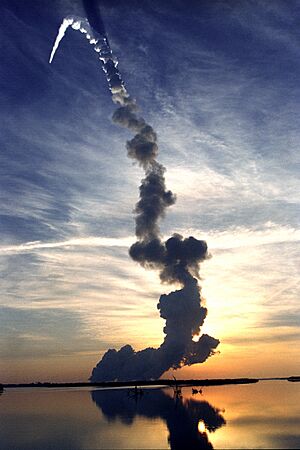
Shuttle Vibration Forces Experiment
The Shuttle Vibration Forces (SVF) Experiment measured how much things vibrated during launch and flight. This helped engineers understand the forces on equipment inside the shuttle. It was the second time this experiment flew into space.
Monitoring the Shuttle's Health
The Orbiter Integrated Vehicle Health Monitoring (IVHM HTD) experiment was about making the Space Shuttle safer. It tested new ways to check the shuttle's systems while it was flying. The goal was to find problems faster and make repairs easier on the ground. This helped improve the overall safety of the vehicle.
A Game in Space
Did you know a copy of the video game StarCraft by Blizzard Entertainment also flew aboard STS-96? It's now kept at Blizzard's headquarters!
Wake-up Calls: Music from Home
NASA has a fun tradition of playing music to astronauts to wake them up. This started during the Gemini program. The songs are often chosen by the astronauts' families. They usually have a special meaning to one of the crew members or relate to their daily tasks in space.
| Flight Day | Song | Artist |
|---|---|---|
| Day 2 | "California Dreamin" | Mamas and the Papas |
| Day 3 | "Danger Zone" | Kenny Loggins |
| Day 4 | Themes from Star Wars | Space Center Intermediate Band |
| Day 5 | "Morning Colors" | US Coast Guard Band |
| Day 6 | "Amarillo by Morning" | George Strait |
| Day 7 | "Exultate Jubilate" | Mozart |
| Day 9 | "Free Bird" | Lynyrd Skynyrd |
Images for kids
See also
 In Spanish: STS-96 para niños
In Spanish: STS-96 para niños


